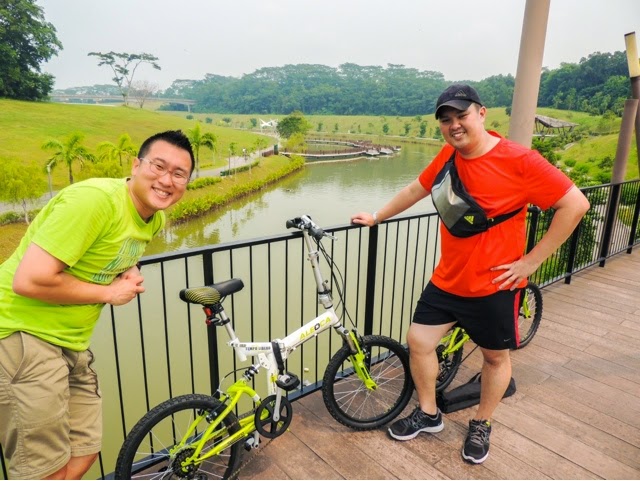In my defence, I did ask Mary before actually signing up for the People's Association (PA) Water Venture kayaking excursion at Jurong Lake, one installment of a four-part series of guided excursions at four reservoirs around Singapore.
Er, Jurong Lake, I confirmed.
The West looms large in many Singaporean imaginations as a metaphor of distance. The name Jurong Lake seems to add to this mythical status. I could have added for good measure that we were going there to look for Excalibur. There is absolutely no rhyme or reason why we who dwell in Ang Mo Kio should be found in deepest Jurong on a Sunday morning when deepest sleep seems a fairly decent alternative.
Below: a familiar view from all those NIE-bound journeys earlier. I think most will agree that the stretch between Chinese Garden and Lakeside MRT Stations is one of the more scenic stretches.
Mary has a one-word answer to every activity I suggest - proposal? by which she means a detailed breakdown of location, duration and terrain. Very encouragingly, each time my responses to her have progressively evoked less incredulity and revulsion (though it is entirely debatable whether the latter emotion has since been replaced with resignation). And before this descents into another gender stereotype imbroglio about me underestimating my wife, the reader will have to acknowledge that not everybody can be expected to love being under the sun. Out of love (and out of her own volition - no, love is not coercive), Mary has followed me through some very uncomfortable situations as I chased waterfalls and mountain vistas. Today was no lesser an expression of her love.
Our previous outing with Kayakasia led us to expect a similar degree of freedom on this excursion. Unfortunately, the Water Venture people meant every letter of the word guided. It was still enjoyable. The weather was brilliant - intermittently cloudy so we weren't completely baked. After the choppy prelude on the seaward passage towards Sungei Simpang last month, the calm waters of Jurong Lake seemed a world apart. Yet starting at a quarter to ten meant our flotilla of kayaks getting the gathering force of the steadily climbing morning sun.
As we were hustled from point to point, I thought the best arrangement for the both of us was for me to keep up with the pack, while Mary got us the photographs. I want to enjoy paddling too was Mary's steely insistence, when I thrust the camera forwards. I could have misread that, but I was very glad. My wife seemed to have gotten the hang of kayaking.
My memory of the Chinese and Japanese Gardens is hazy, having last visited as a child with my parents. I had plain forgotten about the waterways leading out of Jurong Lake and into the garden grounds. One would think these waterways were the result of creative canalisation. Well, in a way they were - but more accurately speaking, the gardens were actually built on islands raised in the middle of the Jurong River when it was dammed in the 1970s, part of an effort to alleviate the then dour industrial complexion of Jurong. Access to these waterways is controlled, to prevent the unwary from being swept out to sea when the tidal gates are opened.
Below: the various iconic landmarks within the Gardens, viewed from rather unfamiliar angles. Their Chinese names, typically, have a poetic slant only imperfectly rendered in English - Cloud Piercing Pagoda (second from top) and White Rainbow Bridge (bottom-most) are two such names.
The waterways have also ensured the Gardens' growing stature as a local birding hotspot. Indeed, we saw a fair few enthusiasts with all manners of characteristically unwieldy lenses and camera stands.
Above: a very distinctive branch - a purple heron surveys its surroundings.
Below: the commoner grey herons. How many can you count in the heron tree?
We completed the approximately 5-kilometre circuit in a little under three hours, which included time spent photosynthesizing at various rest points. We could have had a richer experience, had we been afforded the opportunity to explore the place at our own pace. It was better than nothing, I must say. There was enough fuel left in us after to perform a quick building inspection at JEM, and to undertake the arduous journey home.






















